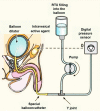Molecular Surgery Concept from Bench to Bedside: A Focus on TRPV1+ Pain-Sensing Neurons
- PMID: 28626428
- PMCID: PMC5455100
- DOI: 10.3389/fphys.2017.00378
Molecular Surgery Concept from Bench to Bedside: A Focus on TRPV1+ Pain-Sensing Neurons
Abstract
"Molecular neurosurgery" is emerging as a new medical concept, and is the combination of two partners: (i) a molecular neurosurgery agent, and (ii) the cognate receptor whose activation results in the selective elimination of a specific subset of neurons in which this receptor is endogenously expressed. In general, a molecular surgery agent is a selective and potent ligand, and the target is a specific cell type whose elimination is desired through the molecular surgery procedure. These target cells have the highest innate sensitivity to the molecular surgery agent usually due to the highest receptor density being in their plasma membrane. The interaction between the ligand and its receptor evokes an overactivity of the receptor. If the receptor is a ligand-activated non-selective cation channel, the overactivity of receptor leads to excess Ca2+ and Na+ influx into the cell and finally cell death. One of the best known examples of such an interaction is the effect of ultrapotent vanilloids on TRPV1-expressing pain-sensing neurons. One intrathecal resiniferatoxin (RTX) dose allows for the receptor-mediated removal of TRPV1+ neurons from the peripheral nervous system. The TRPV1 receptor-mediated ion influx induces necrotic processes, but only in pain-sensing neurons, and usually within an hour. Besides that, target-specific apoptotic processes are also induced. Thus, as a nano-surgery scalpel, RTX removes the neurons responsible for generating pain and inflammation from the peripheral nervous system providing an option in clinical management for the treatment of morphine-insensitive pain conditions. In the future, the molecular surgery concept can also be exploited in cancer research for selectively targeting the specific tumor cell.
Keywords: TRPV1; apoptosis; capsaicin; necrosis; resiniferatoxin; sensory neurons; vanilloids.
Figures




Similar articles
-
Mechanism of capsaicin receptor TRPV1-mediated toxicity in pain-sensing neurons focusing on the effects of Na(+)/Ca(2+) fluxes and the Ca(2+)-binding protein calretinin.Biochim Biophys Acta. 2013 Jul;1833(7):1680-91. doi: 10.1016/j.bbamcr.2012.08.018. Epub 2012 Sep 5. Biochim Biophys Acta. 2013. PMID: 22982061
-
Activation of endogenous TRPV1 fails to induce overstimulation-based cytotoxicity in breast and prostate cancer cells but not in pain-sensing neurons.Biochim Biophys Acta. 2016 Aug;1863(8):2054-64. doi: 10.1016/j.bbamcr.2016.05.007. Epub 2016 May 11. Biochim Biophys Acta. 2016. PMID: 27180305
-
Loss of TRPV1-expressing sensory neurons reduces spinal mu opioid receptors but paradoxically potentiates opioid analgesia.J Neurophysiol. 2006 May;95(5):3086-96. doi: 10.1152/jn.01343.2005. Epub 2006 Feb 8. J Neurophysiol. 2006. PMID: 16467418
-
Resiniferatoxin: The Evolution of the "Molecular Scalpel" for Chronic Pain Relief.Pharmaceuticals (Basel). 2016 Aug 11;9(3):47. doi: 10.3390/ph9030047. Pharmaceuticals (Basel). 2016. PMID: 27529257 Free PMC article. Review.
-
Complex Regulation of TRPV1 by Vanilloids.In: Liedtke WB, Heller S, editors. TRP Ion Channel Function in Sensory Transduction and Cellular Signaling Cascades. Boca Raton (FL): CRC Press/Taylor & Francis; 2007. Chapter 6. In: Liedtke WB, Heller S, editors. TRP Ion Channel Function in Sensory Transduction and Cellular Signaling Cascades. Boca Raton (FL): CRC Press/Taylor & Francis; 2007. Chapter 6. PMID: 21204495 Free Books & Documents. Review.
Cited by
-
TRPV1-Targeted Drugs in Development for Human Pain Conditions.Drugs. 2021 Jan;81(1):7-27. doi: 10.1007/s40265-020-01429-2. Drugs. 2021. PMID: 33165872 Review.
-
The Impact of TRPV1 on Cancer Pathogenesis and Therapy: A Systematic Review.Int J Biol Sci. 2021 May 11;17(8):2034-2049. doi: 10.7150/ijbs.59918. eCollection 2021. Int J Biol Sci. 2021. PMID: 34131404 Free PMC article.
-
Transient Receptor Potential Cation Channel Subfamily V Member 1 Expression Promotes Chemoresistance in Non-Small-Cell Lung Cancer.Front Oncol. 2022 Mar 25;12:773654. doi: 10.3389/fonc.2022.773654. eCollection 2022. Front Oncol. 2022. PMID: 35402237 Free PMC article.
-
Apoptosis and (in) Pain-Potential Clinical Implications.Biomedicines. 2022 May 27;10(6):1255. doi: 10.3390/biomedicines10061255. Biomedicines. 2022. PMID: 35740277 Free PMC article. Review.
-
Supraspinal-selective TRPV1 desensitization induced by intracerebroventricular treatment with resiniferatoxin.Sci Rep. 2017 Sep 29;7(1):12452. doi: 10.1038/s41598-017-12717-5. Sci Rep. 2017. PMID: 28963471 Free PMC article.
References
Publication types
LinkOut - more resources
Full Text Sources
Other Literature Sources
Miscellaneous

